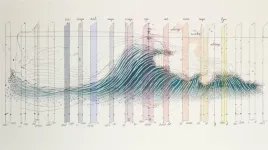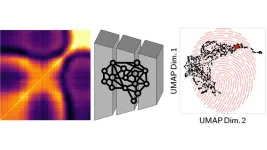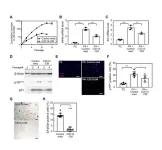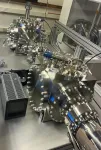(Press-News.org) ANN ARBOR, Michigan — As cancer treatment and survivorship care relies more on understanding the genetic make-up of an individual’s tumor, a new study from the University of Michigan Health Rogel Cancer Center finds that many breast cancer survivors who meet criteria for genetic counseling and testing are not receiving it.
The good news: Among those who do get testing, nearly two-thirds who have a genetic variant are reaching out to family members to talk about their results.
“Our findings support a rapidly growing movement to simplify clinical guidelines to increase access to genetic testing and clinical impact of the results after diagnosis and into survivorship,” said lead study author Steven J. Katz, M.D., M.P.H., professor of internal medicine and of health management and policy at the University of Michigan.
Researchers surveyed 1,412 women seven months and again six years after they were diagnosed with early stage breast cancer. The patients were identified through Georgia and Los Angeles County Surveillance Epidemiology and End Results, or SEER, registries. Participants were asked whether they received genetic counseling or testing and if so, whether they talked with relatives about results.
Clinical guidelines are changing to include more people eligible for genetic testing. The tests themselves are including more genes that could help guide not only treatment but follow-up care and screening. Results can also impact family members who may also be at increased risk of cancer.
The study found that nearly three-quarters of patients who were eligible for genetic testing at diagnosis received it over the study period. Just over half of patients who had indications for testing during follow-up care received it and about a third with no indications received testing.
Those who got testing and found they had a genetic variant were most likely to talk with their family about the results compared with those who did not.
Researchers also found that few people were interested in direct-to-consumer genetic tests, which are not as sophisticated as clinical-based genetic testing and counseling. Results are published in the Journal of Clinical Oncology.
“Genetic risk evaluation and testing can fall through the cracks during survivorship as patients’ needs for ongoing treatments, managing the side-effects of treatments, and monitoring for recurrence or progression grow,” said senior study author Lauren Wallner, Ph.D., M.P.H., associate professor of internal medicine and epidemiology at U-M. Wallner is also the co-leader of Rogel’s cancer control and population sciences program.
“Our findings reinforce the need for novel approaches to genetic risk evaluation and testing in practice to target prevention and early detection strategies for their patients and their families,” said senior study author Allison Kurian, M.D., M.Sc., professor of medicine and of epidemiology and population health at Stanford Medicine.
Researchers have additional studies planned to look at how survivorship care is coordinated between oncologists and primary care providers with a goal of improving survivorship care.
Additional authors: Paul Abrahamse, Allison Furgal, Rachel Hodan, Rachel S. Tocco, Kevin C. Ward, Ann S. Hamilton
Funding for this work is from American Cancer Society grant RSG-19-015-01, National Cancer Institute grants P01 CA163233 and P30 CA046592
Disclosure: None
Paper cited: “Genetic counseling, testing and family communication into survivorship after diagnosis of breast cancer,” Journal of Clinical Oncology. DOI: 10.1200/JCO.24.00122
Resources:
University of Michigan Rogel Cancer Center, www.rogelcancercenter.org
Michigan Medicine Cancer AnswerLine, 800-865-1125
# # #
END
Sleep and wake: they’re totally distinct states of being that define the boundaries of our daily lives. For years, scientists have measured the difference between these instinctual brain processes by observing brain waves, with sleep characteristically defined by slow, long-lasting waves measured in tenths of seconds that travel across the whole organ.
For the first time, scientists have found that sleep can be detected by patterns of neuronal activity just milliseconds long, 1000 times shorter than a second, revealing a new way to study and understand the basic brain ...
Study shows how materials change as they are stressed and relaxed.
Like people, materials evolve over time. They also behave differently when they are stressed and relaxed. Scientists looking to measure the dynamics of how materials change have developed a new technique that leverages X-ray photon correlation spectroscopy (XPCS), artificial intelligence (AI) and machine learning.
This technique creates “fingerprints” of different materials that can be read and analyzed by ...
Most stars in our universe come in pairs. While our own Sun is a loner, many stars like our Sun orbit similar stars, while a host of other exotic pairings between stars and cosmic orbs pepper the universe. Black holes, for example, are often found orbiting each other. One pairing that has proved to be quite rare is that between a Sun-like star and a type of dead star called a neutron star.
Now, astronomers led by Caltech's Kareem El-Badry have uncovered what appear to be 21 neutron stars in orbit around stars like our Sun. Neutron stars are dense burned-out ...
“[...] the present results strongly suggest the potential of PEDF as a myokine linking exercise training to the suppression of senescence.”
BUFFALO, NY- July 16, 2024 – A new research paper was published on the cover of Aging (listed by MEDLINE/PubMed as "Aging (Albany NY)" and "Aging-US" by Web of Science) Volume 16, Issue 13, entitled, “Roles of pigment epithelium-derived factor in exercise-induced suppression of senescence and its impact on lung pathology in mice.”
Senescent cells contribute ...
“[...] we found an independent positive prognostic effect of HER2-low compared to HER2-zero in early breast cancer.”
BUFFALO, NY- July 16, 2024 – A new editorial paper was published in Oncotarget's Volume 15 on June 20, 2024, entitled, “HER2-low and HER2-zero in breast cancer between prognosis, prediction and entity.”
In this new editorial, researchers Marcus Schmidt, Hans-Anton Lehr, and Katrin Almstedt from the University Medical Center of Johannes Gutenberg University discuss HER2 in breast cancer. HER2 is a well-established prognostic and predictive factor in breast ...
CAMBRIDGE, MA — Foundation models are massive deep-learning models that have been pretrained on an enormous amount of general-purpose, unlabeled data. They can be applied to a variety of tasks, like generating images or answering customer questions.
But these models, which serve as the backbone for powerful artificial intelligence tools like ChatGPT and DALL-E, can offer up incorrect or misleading information. In a safety-critical situation, such as a pedestrian approaching a self-driving car, these mistakes could have serious consequences.
To help prevent such mistakes, researchers from MIT and the MIT-IBM Watson AI Lab developed a technique to estimate the reliability ...
WASHINGTON, D.C. - Today, the U.S. Department of Energy (DOE) and the Defense Advanced Research Projects Agency (DARPA) announce a Memorandum of Understanding (MOU) to coordinate efforts to move the needle on quantum computing.
“Realizing practical quantum computers has the potential to dramatically accelerate the pace of discovery across the science and technology landscape,” said Ceren Susut, DOE Associate Director of Science for the Advanced Scientific Computing Research program. “The Office of Science is proud to bring decades of experience in fundamental science for quantum ...
Each cell in the body has its own unique delivery system that scientists are working on harnessing to move revolutionary biological drugs — molecules like proteins, RNA and combinations of the two — to specific diseased parts of the body.
A new study from Northwestern University hijacked the transit system and sent tiny, virus-sized containers to effectively deliver an engineered protein to its target cell and trigger a change in the cell’s gene expression. The success came from encouraging engineered proteins to move toward a specific cell membrane structure that the researchers found increased a protein’s likelihood of latching onto the container.
Published ...
SAN ANTONIO — July 16, 2024 — Researchers from Southwest Research Institute (SwRI) and The University of Texas at Dallas (UTD) are collaborating to evaluate a next-generation sensor designed to measure neutral gas velocities in the Earth’s upper atmosphere. The project, led by SwRI’s Dr. Joo Hwang and UTD’s Dr. Phillip Anderson, is supported by a grant from the new SwRI/UTD Seed Projects for Research, INnovation, and Technology (SPRINT) Program. Another SPRINT project is researching domestic lithium independence, looking at ...
AMHERST, Mass. – A new global assessment of scientific literature led by researchers at the University of Massachusetts Amherst finds that nature-based solutions (NbS) are an economically effective method to mitigate risks from a range of disasters—from floods and hurricanes to heatwaves and landslides—which are only expected to intensify as Earth continues to warm.
NbS are interventions where an ecosystem is either preserved, sustainably managed or restored to provide benefits to society and to nature. For instance, they can mitigate risk from a natural disaster, or facilitate climate mitigation and adaptation. NbS ...






